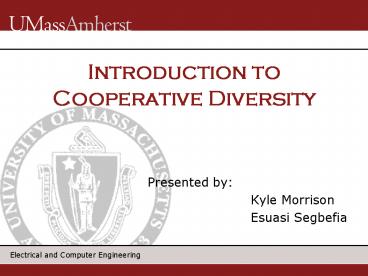Introduction to Cooperative Diversity - PowerPoint PPT Presentation
Title:
Introduction to Cooperative Diversity
Description:
The channel gain is not only a function of time, but also of ... signal interference at the antenna; antenna is able to properly ... Antenna. Isolation ... – PowerPoint PPT presentation
Number of Views:276
Avg rating:3.0/5.0
Title: Introduction to Cooperative Diversity
1
Introduction to Cooperative Diversity
- Presented by
- Kyle Morrison
- Esuasi Segbefia
2
Outline
- Review of Previous Discussion
- Interference Modeling (Dons question)
- Introduction to Cooperative Diversity
- Algorithms
- Performance
- Challenges
- Future Research
3
Bit Error Rate vs SNR
- P1 1/SNR
- P2 1/SNR2
- P3 1/SNR3
- P4 1/SNR4
- P5 1/SNR5
Jensens Inequality
- Increasing SNR (i.e. increasing transmit power)
doesnt buy much. - Increasing the amount of diversity drastically
improves the links reliability.
4
Space Diversity
- The channel gain is not only a function of time,
but also of position, h(t, r). - The transmitter must far enough so that it sees
a different channel. Whats far enough? - This is the same as coherence time for time
diversity.
5
Space Diversity
Far Enough l/2
- Most cell towers have multiple transmit cells
servicing one cell. - On the down link channel, the system is a MISO
system. - The antennas must be spaced at least l/2 apart
to see independent channels.
6
Space Diversity
The probability that all four channels are in
deep fade is much smaller than the probability
that any one channel is in a deep fade.
- Multiple antennas at phone and at base station,
this is a MIMO system. - The cost is receiver/transmitter complexity.
- The benefit is that the BER is approximately
1/SNRL.
7
Interference Signal to Interference Noise Ratio
SINR
Source http//mathdemos.gcsu.edu/mathdemos/cellsi
r/cellsir.html
8
Radio Assumptions
- Half duplex transmit or receive one at a time.
- Fading coefficients are known at receivers.
- Isolation
- Small receive signal power Large transmit
signal power. - Signal Isolation No signal interference at the
antenna antenna is able to properly
differentiate between transmit and receive
signals.
Isolation Diagram
9
Metrics
- Ergodic / Shannon Capacity takes the average
rate of transmission over time. - If rate is above threshold, link is good.
- If rate is below threshold, link is not good.
- Equation
- Outage Probability the probability that a mutual
information random variable falls below some
fixed rate ahead of time. - More concerned with the probability that the link
can sustain a given rate - Equation
10
Definition
- Ar,s fading coefficients, in this case between
the relay and source - Important to note that fading coefficients are
assumed to be known at the receivers - Relay performs transmission and receiving of
information. - Spatial Diversity using two or more antennas
separated in space so that they provide more
paths to/from a source or destination.
11
What is Cooperative Diversity
- Cooperative - working or acting together
willingly for a common purpose or benefit. - Diversity - variety multiformity
- Cooperative Diversity
- Relay
- Fading Channel
- Spatial Diversity
12
Cooperative Diversity
- One Source and another source which acts as a
relay and a base station
13
Relay Algorithms
- Amplify and Forward
- Decode and Forward
- Selection and Dynamic Relaying
- Incremental Relaying
14
Amplify and Forward
- Relay performs amplification of received signal
- Benefits
- Greater Diversity
- Low complexity
- Faults
- Decrease Bandwidth Efficiency
- Scheduling
- Equation
15
Decode and Forward
- Relay partitions its own bits and source bits
into two separate frames. - Benefits and Disadvantages similar to Amplify and
Forward
16
Selection and Dynamic Relaying
- Similar to decode and forward but implements a
Decision Region algorithm - Fading coefficient falls below threshold then we
transmit using non-cooperative techniques - Fading coefficient falls above threshold then we
transmit using cooperative techniques like decode
and forward and amplify and forward - Two of the fading coefficients have to be low for
information lost
17
Coded Cooperation
18
Incremental Relaying
- Send an acknowledgment bit to indicate whether
the message was received correctly - If a positive acknowledgment is made at the
destination then do nothing - If provided a negative acknowledgment then a
request is made to transmit via relay - Relay uses amplify and forward algorithm
- Benefits
- Bandwidth
- Disadvantages
- Time delay
19
Performance
- Decode and Forward offers better diversity than
Amplify and Forward regardless of the quality of
the source-relay link - Generally, the more relays you have the better
the diversity.
COOPERATIVE DIVERSITY Models, Algorithms, and
Architectures Cooperation in Wireless Networks
Principles and Applications Real Egoistic
Behavior is to Cooperate! Fitzek, Frank H.P.
Katz, Marcos D. (Eds.) Springer, 2006.
20
Challenges
- Obvious Challenges Higher Layer Protocols and
mechanisms. - Development of Hardware Testbeds to demonstrate
functionality. - Overhead in transmitting network metrics across
source-relay-destination nodes. - Power/Energy conservation.
21
Future Research
- Management of multi-user networks.
- Link interaction in complicated network
architecture. - Development of power control mechanisms for
cooperative transmissions - Enhanced coding scheme for cooperative
communication.































